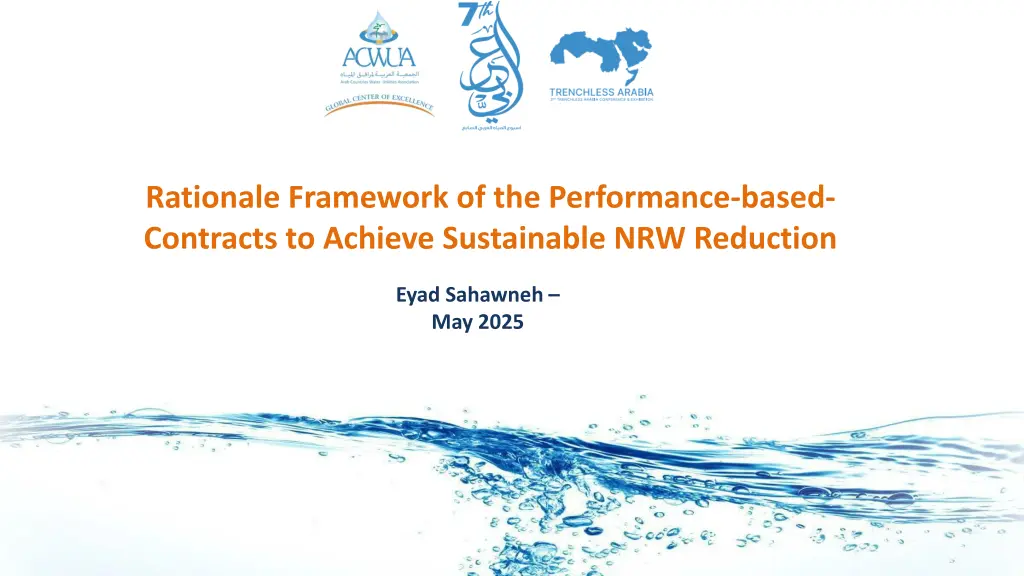
Achieving Sustainable NRW Reduction Through Performance-based Contracts
Explore the rationale framework and strategic decision-making involved in utilizing performance-based contracts to achieve sustainable Non-Revenue Water (NRW) reduction. Uncover the associated risks and considerations for successful implementation, presented in a detailed analysis by Eyad Sahawneh.
Download Presentation

Please find below an Image/Link to download the presentation.
The content on the website is provided AS IS for your information and personal use only. It may not be sold, licensed, or shared on other websites without obtaining consent from the author. If you encounter any issues during the download, it is possible that the publisher has removed the file from their server.
You are allowed to download the files provided on this website for personal or commercial use, subject to the condition that they are used lawfully. All files are the property of their respective owners.
The content on the website is provided AS IS for your information and personal use only. It may not be sold, licensed, or shared on other websites without obtaining consent from the author.
E N D
Presentation Transcript
Rationale Framework of the Performance-based- Contracts to Achieve Sustainable NRW Reduction Eyad Sahawneh May 2025
Performance-based-Contracts (The How) Result-oriented, measurable improvements and time-bounding. Dual benefits: remember the composite materials, or your baby-first-step. Applicable and already implemented both in developing and developed countries. PBCs are not exchangeable-used-terminology or naturally-linked to PPPs. The spark: outsourcing slipped to the programs that can pay for themselves. Lower associated risks, but risk is shared not delegated: The contracting party assumes substantial risk but has the flexibility and discretion to determine how outcomes will be achieved. Typically, fees split into fixed and variable and phased to reduce then maintain. Lifecyle: early assessment baselining/ diagnostics development and investment planning transaction design/ tender procurement familiarization reduction maintain scale-up. It has types corresponding to objective, payment, prerequisites and baselining such as for incentivized PMC, cost plus, SO24/7, DBOM, etc. Usually, PBCs are mechanism that effectively works under funding constrained environments. Regression analysis shows that well-designed NRW-PBCs are 68 percent more effective in achieving NRW reduction than utility-led NRW reduction program.
Strategic Decision-Making Pre-Feasibility Studies. How much investment/ budget is needed? Gap Analysis and Need Evaluation. Business Case Assembly/ Recommendation. Are the Prerequisites enable PBC Model (GO vs NO GO) Financial Modeling (NPV, ROI, IRR, PBP, ROM and BCR) Investment Atmosphere/ Market. Institutional & Regulatory Framework. National Master Plans/ Strategies. Scope Validation Governing the PBC Style Funding Mechanisms/ Eligibility Condition & Operational Assessment. Precedents Requirements.
Associated Risks of NRW-PBC Inflation rates. Currency devaluation. No baselines nor diagnostics established. Utility failed to perform its primary obligations. Uncontrolled policy change. Rigidity of terms and conditions. Inability of client/ utility to measure/ monitor or audit. Unclarity of autonomous and neutrality. Payments failed to be due as per agreement. Lacked capacity to manage/ supervise PBCs. Contractor is not performing. Sustainability not securable. Durations/ timeframes are not sufficiently designed. Familiarization step design. By-products: is the utility looking for low-hanging fruits or planting trees? short & long terms.
The Paradox of Empty Box Immaturity of market conditions and confused budgeting allocations Data is not reliable or valid asking too many how and how much PESTLE is not up-to-the-point and deficiencies of procurement process Local context is not ready for or appreciate the initiative itself No demonstrated guarantees and fictional PQ requirements KPI design/ baselining methods are not clear or properly selected IN ADDITION: understanding when NRW/PBC are not the right solution Unrealistic mandatory performance targets and goals
Project Goals and NRW Solutions Provide fully-CWS regime to more customers. Expand the service delivery for more customers. Ensure sufficient water is available to meet projected demand growth. Improved resilience and security of supply considering climate change and associated risks. Improve financial indicators and commercial performance. Establish prerequisites necessary to achieve readiness of transitional IWS into CWS. Institutionalization of water utilities business functions and NRW performance. Enable water supply system to accommodate additional substantial water quantities.
Recommendations and Best Practices Duration: Timeframes. Viability. Technical studies. Detailed assessment. Delays impact. Tendering & Evaluation: Qualifications. Voluminous submissions. Fair and equitable contract model. Reduction targets. Selection criteria. Familiarization period. Results sustainability measures. Baselining and KPIs Matrix: NRW only can be misleading. Method of calculation. Adjustments and change events. Weights and performance ruler. Exclusions and prerequisites. Operational Perspectives: Protocols governing obligations. Independent auditor/ 3rd party. Water supply and emergencies. Capacity building approach/ TOC. Carrot and stick (tech & fin). Willingness/ responsiveness. Transfer and exit planning.
An Outlook to the Financing Options Scenarios of use that: Utility revenue generation/ cashflows. Successfully worldwide that: Lump-sum payment for achieving the NRW Government grant/ transfers. reduction target. Performance-based management fee, linked to Concessional loans. Debt or equity. actual water savings achieved. 30% of compensation is performance-based, with In addition to the consideration of that: payment based on NRW reduction volume. Fixed versus performance fees (70/30). Contractors paid based on increased volumes billed BOQ, cost plus and incentive scheme. (billed-growth). Saving shares and weighted scores. More than 70% of remuneration for leakage Far-sighted investment not gold-plating. reduction activities and management services was Capital gain share. performance-based, based on m3/day saved. Target-driven and economical level set.
Key Takeaways Using PBC for NRW reduction is not always the right way to follow, it depends. The detailed assessment is better to be part of the Performance Contractor scope and subjected to negotiation and further verification once parties are step into setting the targets (agility required). Risk should be balanced and reasonable to attract private sector participation (realistic targets). The time for procurement should be as much as possible shorten, simple and clear. Engage stakeholders and focus on practical solutions over theories to ensure operational continuity. Consider sustainability measures (planning, resources, capacity building, adaptive management, etc.). Familiarization phase is quite important, should be planned in detail and solidly integrated to contract. . Evaluation criteria should follow a combination of everything, not rigidly designed/ increase T over F. Independent audit/ third party and supervisory roles are a must to succeed/ Liabilities Discussion. Contract duration should be fair, corresponding to realistic targets and water supplies commitment. Service level agreements, provisional sums, and other options are important to consider. Baselining methods, KPIs matrix design and prerequisites are important, avoid only NRW indicator. Primary obligations between utility and performance contractor should be applicable and valid. Incentive should be ascending to encourage performance improvement, not to be black or white.

